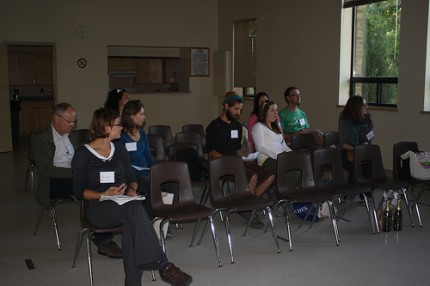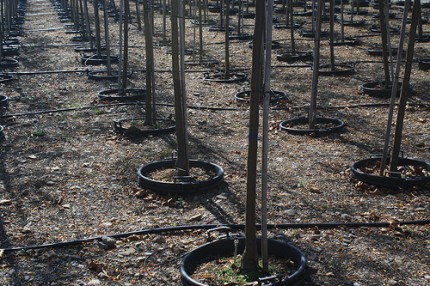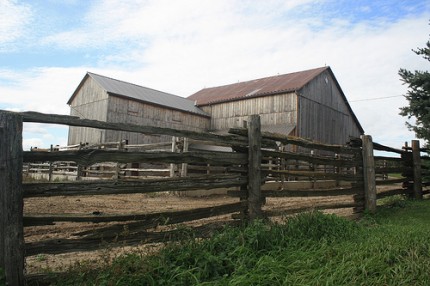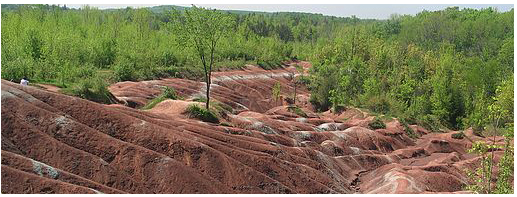City to Country Virtual Tour #4: Environmental Goods and Services
Posted: July 2, 2012
Categories: GoodFoodBites / Growing Good Food Ideas / News from Sustain Ontario / Virtual Tours
In September 2011 the way I looked at the landscape changed. Being a part of the Environmental Goods and Services tour during the City to Country Mobile Conference was an education in ecological accounting. The world provides us with goods and services at no cost. When we fail to take the value of the services nature provides into account, we often fail to protect them.
 At Credit Valley Conservation, our first stop, Mark Eastman began with an explanation of environmental services, their importance, as well as programs and information Credit Valley provides to farmers and other landowners to help assess and improve the state of their land. All ecosystems have natural capital, which is the total of the assets of an ecosystem that produce ecological services. Ecological services are the benefits that people enjoy from the presence of functioning natural ecosystems, for example in the Credit River watershed, these include providing clean drinking water, clean air, food and other materials. We can approximate the value of these natural services by calculating how much it would cost to provide this service ourselves. In the case of clean water, its value is impacted by the cost to treat and transport the same volume.Farmers, with the help of Credit Valley Conservation, can develop an environmental farm plan, to highlight their farm’s environmental strengths, identify areas of concern and set realistic goals to improve environmental conditions. Cost-share programs are available to assist farmers with their projects. Similar programs, such as the Norfolk ALUS project, also provide support. On Y U Ranch, Brian Gilvesy used the program to restore native tall-grass prairie, which provides a steady, healthy supply of food for the Texas Longhorn cattle raised there.
At Credit Valley Conservation, our first stop, Mark Eastman began with an explanation of environmental services, their importance, as well as programs and information Credit Valley provides to farmers and other landowners to help assess and improve the state of their land. All ecosystems have natural capital, which is the total of the assets of an ecosystem that produce ecological services. Ecological services are the benefits that people enjoy from the presence of functioning natural ecosystems, for example in the Credit River watershed, these include providing clean drinking water, clean air, food and other materials. We can approximate the value of these natural services by calculating how much it would cost to provide this service ourselves. In the case of clean water, its value is impacted by the cost to treat and transport the same volume.Farmers, with the help of Credit Valley Conservation, can develop an environmental farm plan, to highlight their farm’s environmental strengths, identify areas of concern and set realistic goals to improve environmental conditions. Cost-share programs are available to assist farmers with their projects. Similar programs, such as the Norfolk ALUS project, also provide support. On Y U Ranch, Brian Gilvesy used the program to restore native tall-grass prairie, which provides a steady, healthy supply of food for the Texas Longhorn cattle raised there.
As the tour continued, we stopped to see examples of land in the midst of restoration, including Stone Ridge Farm. Stone Ridge is a family farm near the headwaters of the Credit River. Runoff from cattle manure had raised issues of water quality, so a cement paddock was installed around the barn, designed for easy cleaning, and to slow down and divert runoff. Due to their proximity to sensitive wetlands, the owners at Stone Ridge feel a responsibility to ensure the water downstream remains clean. While the work may not directly increase profit, a question advocates of restoring ecological services frequently encounter, it does increase the health of the farm and maintain a rich ecosystem for future generations to enjoy.
The Cheltenham Badlands, a brief but memorable stop, provided a stark contrast, illustrating what can happen when land is degraded through improper or overuse. This particular stretch of badland was produced by intensive farming practices.
Next up was Sheridan Nurseries, which promotes environmental initiatives that can be readily adapted to other farms/growers/businesses. These initiatives include:

- The addition of cocoa-fiber discs to plant containers, reducing water loss by 30%
- The construction of a stormwater pond to catch rainwater and runoff
- The use of drip irrigation rather than sprinklers or broadcast watering has reduced water consumption by 80%
- The use of natural spot treatment of pests
- Composting organic waste, biodegradable pots and pot recycling
- A 100,000 gallon cistern captures rain water from production greenhouses
- Growing plants that require less water
- The use of double pots for trees, reducing water and soil loss
Last but not least, we stopped in at Emery Collegiate Institute for our final stop. The PACT Pollinator Garden, coordinated by co-facilitator Sabrina Malach, intends to develop a replicable model for urban agro-ecological practices, which promote the reality that sustainable agriculture supports both humans and nature. Students participate in monitoring programs as citizen scientists to identify and count pollinator species, with the aim of raising environmental and community awareness in youth. Students can also volunteer and gain experience in lunch or after-school programs.
PACT’s pollinator garden based on 10 years of research from Sustain Ontario on Vimeo.
One response to “City to Country Virtual Tour #4: Environmental Goods and Services”
Leave a Reply
You must be logged in to post a comment.



alexdombroff@alexanderdombroff.com